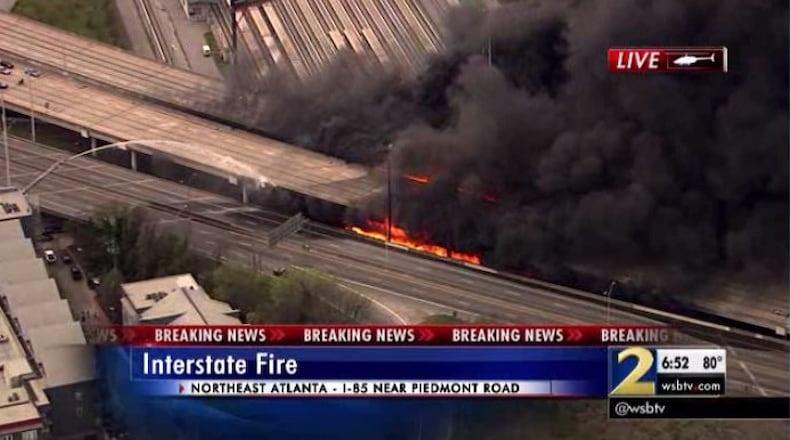A report on the I-85 bridge collapse suggests something many Atlantans might think is obvious: It might have been a bad idea to store material that could catch fire under a highway that carries 250,000 vehicles each day.
The fire – allegedly started by a homeless man – was fueled by large spools of plastic and fiberglass conduit the state stored under the highway for years. Questions about the dangers of storing the material there flared even as firefighters extinguished the March 30 blaze.
The report by the Greater Atlanta Chapter of the Society of Fire Protection Engineers is preliminary - part of a larger state investigation of practices that may have contributed to the bridge fire. It does not say storing the material under the bridge was a bad idea. It draws no conclusions about the cause of the fire, assigns no blame and makes no final recommendations.
But it says Georgia should consider developing detailed rules for storing construction material under highways in light of the fire.
The April 26 report – obtained Tuesday by The Atlanta Journal-Constitution and Channel 2 Action News – lays out some possible guidelines for storing such material. But it's unclear whether such rules would have prevented the fire that destroyed I-85 at Piedmont Road and disrupted Atlanta traffic for six weeks.
GDOT spokeswoman Natalie Dale said the report “provides valuable guidance from subject matter experts on how the department may shape future policies and procedures as they relate to storage of materials around infrastructure.” She said GDOT would share any lesson learned with transportation agencies across the country.
Basil Eleby, has been charged with setting the fire, which spread to the fiber optic cable GDOT stored there. The cable was left over from an aborted attempt to install traffic management equipment on Ga. 400 in 2007.
GDOT Commissioner Russell McMurry has called the material stored under the bridge “non-combustible” – meaning it could not easily catch fire – and has said the fire could not have been foreseen.
He's also said storing construction material under bridges is a common practice. However, several states contacted by the AJC said they do not routinely store such materials under bridges, and at least one prohibits the practice.
State and federal regulations do not prohibit storing construction material under highways. But in the wake of the I-85 fire, the National Transportation Safety Board is reviewing the practice.
McMurry has said similar material is not stored under other state bridges. But he asked State Insurance Commissioner Ralph Hudgens and Fire Marshall Dwayne Garriss to review GDOT’s procedures for storing materials, especially under bridges. The initial report by the Society of Fire Protection Engineers is part of that state investigation.
Among the group’s initial recommendations:
• GDOT should consider developing rules for storing material under bridges, taking into account the quantity, nature and burning characteristics of the material.
• If those characteristics can’t be determined, GDOT should consider limiting all storage under a particular bridge to only noncombustible material.
• If storage of combustible material cannot be avoided under a particular bridge, it should be limited and contained to secure, noncombustible containers and not placed in concentrated piles.
• If the stored material is unattended, the area should be locked or otherwise protected from unauthorized entry.
• If such guidelines can’t be met, the stored material should be moved or GDOT should conduct a fire hazard analysis to assure a reasonable level of safety.
Glenn Allen, a spokesman for the insurance commissioner, said the agency is still gathering information from GDOT, and the state investigation continues.
A spokesman for the National Transportation Safety Board said the agency has obtained samples of the material stored under the bridge and is awaiting lab results that would identify it. It also is reviewing other information submitted by GDOT.
It’s unclear when either investigation will be finished.
Though GDOT has come under fire for its storage practices, it won widespread praise for the quick restoration of the bridge.
Contractor C.W. Matthews worked round the clock to demolish and rebuild 350 feet of elevated highway in each direction. I-85 was completely open by May 13 – a month ahead of schedule. GDOT has said good weather, accelerated construction techniques and a $3.1 million incentive for the contractor helped speed the project.
MYAJC.COM: REAL JOURNALISM. REAL LOCAL IMPACT.
The AJC's David Wickert keeps you updated on the latest in what's happening with transportation in metro Atlanta and Georgia. You'll find more on myAJC.com, including these stories:
Never miss a minute of what's happening in Atlanta transportation news. Subscribe to myAJC.com.
About the Author
The Latest
Featured


